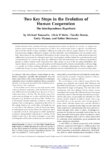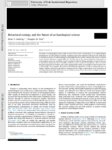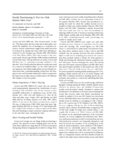1 - 25 of 22
| Creator | Title | Description | Subject | Date | ||
|---|---|---|---|---|---|---|
| 1 |
 |
Rogers, Alan R.; Harpending, Henry C. | Mismatch distributions of mtDNA reveal recent human population expansions | Although many genetic studies of human evolution have tried to make distinctions between the replacement and the multiregional evolution hypotheses, current methods and data have not resolved the issue. However, new advances in nucleotide divergence theory can complement these investigations with a ... | 1994 | |
| 2 |
 |
Rogers, Alan R.; Harpending, Henry C. | Genetic structure of ancient human populations | Discusses mitochondrial DNA (mtDNA) sequences as important source of data about the history of human species. | Tree of descent; Mismatch distributions; Simulations; Findings; Intermatch distributions; Younger and older populations | 2001-09-15 |
| 3 |
 |
Codding, Brian | Codding, Brian: Living outside the box: An updated perspective on diet breadth and sexual division of labor in the Prearchaic Great Basin [Author's Manuscript] | A tremendous amount has been learned about the Prearchaic (before 9000 BP) Great Basin since we advocated a perspective of sexual division of labor based on Human Behavioral Ecology a decade ago. Many investigators have taken our advice and a few have challenged our assumptions and inferences. One o... | 2014-01-01 | |
| 4 |
 |
Rogers, Alan R. | How much can fossils tell us about regional continuity? | Presents a study on the genetic contribution of earlier populations to later populations within regions called regional continuity. Testing for regional continuity with multiple characters; Replacement of archaic population by a population of modern humans. | Human genetics; Fossils; Regional continuity | 2006-06-05 |
| 5 |
 |
Rogers, Alan R. | Genetic variation at the MCIR Locus and the time since loss of human body hair | The melanocortin I receptor (MCIR) locus makes a protein that affects the color of skin and hair. At this locus, amino-acid differences are entirely absent among African humans, abundant among non-Africans (especially Europeans), and abundant in chimpanzee/human comparisons (Rana et al. 1999, Hardin... | Nonsynonymous; Chimpanzee; Constraint | 2004 |
| 6 |
 |
Cashdan, Elizabeth A. | Ethnocentrism and xenophobia: a cross-cultural study | Analyzes the factors influencing ethnic affiliation and interethnic hostility. Relationship between intraethnic loyalty and risk of famine; Continuity of violence at different levels of groupings; Analysis of local and intercommunity conflict. | Ethnic relations; Ethnology | 2006-06-06 |
| 7 |
 |
Loeb, Laurence D. | Prestige and piety in the Iranian synagogue | Among Iranian Jews, long deprived of meaningful political power and afraid to conspicuously display material wealth, relative prestige became more valued that authority of opulence. The synagogue provides the traditional public forum where meaningful interaction among its members reinforces rand dif... | Shirazi Jewish Socieity | 1978 |
| 8 |
 |
Cashdan, Elizabeth A. | Technological change and child behavior among the !Kung | How does change in one part of a social system affect other parts? This is the central question that must be answered in order to understand the process through which culture changes. This paper is about a small piece of the problem. It investigates how changes in subsistence economy affect child be... | Child behavior; Technological change; Foraging groups; Settled groups | 1988 |
| 9 |
 |
Hawkes, Kristen | Human life histories: primate trade-offs, grandmothering socioecology, and the fossil record | Human life histories differ from those of other animals in several striking ways. Recently Smith and Tompkins (1995, p. 258) highlighted the combination of "slow" and "fast" features of human lives. Our period of juvenile dependency is unusually long, our age at first reproduction is late, and we h... | Meat; Maturity; Life Span | 2003 |
| 10 |
 |
Hawkes, Kristen | Stag hunts or rearing environments? | Tomasello et al. have made the case that shared intentionality distinguishes humans from our nearest living relatives. What accounts for the difference? The answer they offer is Stag Hunt choices faced by ancestral foragers. Noting problems with that answer, I urge attention to a promising alternati... | 2012-01-01 | |
| 11 |
 |
Cashdan, Elizabeth A. | Waist-to hip ratio across cultures: trade-offs between androgen-and estrogen-dependent traits | A gynoid pattern of fat distribution, with small waist and large hips (low waist-to-hip ratio, or WHR) holds significant fitness benefits for women: women with a low WHR of about 0.7 are more fecund, are less prone to chronic disease, and (in most cultures) are considered more attractive. Why, then... | Fertility; Optimum; Fecundity | 2008 |
| 12 |
 |
Cashdan, Elizabeth A. | Waist-to-hip ratio across cultures: trade-offs between androgen- and estrogen-dependent traits | A gynoid pattern of fat distribution, with small waist and large hips (low waist-to-hip ratio, or WHR) holds significant fitness benefits for women: women with a low WHR of about 0.7 are more fecund, are less prone to chronic disease, and (in most cultures) are considered more attractive. Why, then... | Fat distribution; Gynoid pattern; Body types; Waist-to-hip ratio; WHR | 2008 |
| 13 |
 |
O'Rourke, Dennis H. | Hrdlič̌ka's Aleutian population-replacement hypothesis: a radiometric evaluation | In a 1945 monograph, Hrdlička argued that, at 1,000 BP, Paleo-Aleut people on Umnak Island were replaced by Neo-Aleut groups moving west along the island chain. His argument was based on cranial measurements of skeletal remains from Chaluka Midden and mummified remains from Kagamil and Ship Rock b... | Population replacement; Paleo-Aleuts; Neo-Aleuts | 2006 |
| 14 |
 |
Codding, Brian | Behavioral ecology and the future of archaeological science | The future of archaeological science relies as much (if not more) on theoretical as on methodological developments. As with anything in biology, explaining past human behavior will require the application of evolutionary theory. As with anything in archaeology, theory is useless without clear ties t... | 2015-01-01 | |
| 15 |
 |
Rogers, Alan R.; Jorde, Lynn B. | Genetic evidence on modern human origins | A review of genetic evidence leads to the following conclusions concerning human population history: (1) Between 33,000 and 150,000 years ago the human population expanded from an initial size of perhaps 10,000 breeding individuals, reaching a size of at least 300,000. (2) Although the initial popu... | Population history; Mitochondrial DNA; Mismatch distribution; Intermatch distribution; Replacement hypothesis; Population bottlenecks | 1995 |
| 16 |
 |
Hawkes, Kristen | Family provisioning is not the only reason men hunt | Gurven and Hill (2009) ask, "Why do mean hunt?" As they say, "The observation that mean hunt and women gather supported the simplistic view of marriage as a cooperative enterprise. Greater sophistication suggests that males may often be motivated by mating and status rather than offspring investment... | 2010-01-01 | |
| 17 |
 |
Hawkes, Kristen | Hadza children's foraging: juvenile dependency, social arrangement and mobility among hunter-gatherers | Presents a study on the foraging activities of Hadza children in Tanzania, Africa. Success of children's foraging; Determinants of children's foraging; Monitoring of the activities of children; Near-camp foraging return rates; Variables underlying the patterns of foraging. | Children; Foraging; Hazda; Hunter-gatherers | 1995 |
| 18 |
 |
Broughton, John | Homestead cave Ichthyofauna | Biological evidence on the climatic and hydrographic history of the intermountain region would be much richer, if we had more than the present dribble of paleontological data on the fishes (Hubbs and Miller, 1948, p. 25). In this passage from their landmark synthesis of historical fish biogeograph... | Homestead Cave; Ichthyofauna; Lake Bonneville | 2000 |
| 19 |
 |
Cashdan, Elizabeth A. | Competition between foragers and food producers on the Botletli River, Botswana | The immigration of food-producing groups into areas occupied by hunters and gatherers must have been a common occurrence in prehistory. How were the hunter-gatherers affected by this? I describe here two groups of Kalahari Basarwa ('Bushmen'), one living along the flood plain of the lower Botletli ... | Kalahari Basarwa; Bushmen; Foraging; Cattle | 1986 |
| 20 |
 |
Codding, Brian F. | Socioecological dynamics structuring the spread of farming in the North American Basin-Plateau Region | The spread of agriculture is a major driver of social and environmental change throughout 25 the Holocene, yet experimental and ethnographic data indicate that farming is less profitable than foraging, so why would individuals choose to adopt agriculture leading to its expansion? Ideal distribution ... | Ideal free distribution model; population ecology; behavioral ecology; maize agriculture; Ancestral Puebloan; Fremont Complex | 2021 |
| 21 |
 |
McElreath, Richard | Are peasants risk-averse decision makers? | For decades, researchers studying small-scale, subsistence-oriented farmers have sought to explain why these "peasants" seem slow to acquire new technologies, novel agricultural practices, and new ideas from the larger societies that have engulfed them. The early work on this question suggested that... | Subsistance farmers; Risk-aversion; Risk-taking; Cultural conservatism; Cost-benefit analysis | 2002 |
| 22 |
 |
Hawkes, Kristen | Hunting and nuclear families: some lessons from the Hadza about men's work | Hadza hunter-gatherers display economic and social features usually assumed to indicate the dependence of wives and children on provisioning husbands and fathers. The wives and children of better Hadza hunters have been found to be better-nourished, consistent with the assumption that men hunt to pr... | Subsistence economy; Tindiga, African people; Subsistence hunting | 2001-10-24 |
1 - 25 of 22
